Pull-Out Mechanism of Horizontal and Inclined Plate Anchors in Normally Consolidated Clay
Abstract
:1. Introduction
2. Anchor Shape and Inclination
3. Experimental Set-Up and Procedure
3.1. Centrifuge Model Set-Up
3.2. Sample Preparation
3.3. Anchor Loading Configuration
3.4. Test Procedure Step (1): Anchor Installation and Soil Re-Consolidation
3.5. Test Procedure Step (2): Pull-Out Test
4. Verification Tests
4.1. Soil Profiles
4.2. Verification of Anchor Uniform Settlement with Adjacent Soil during Re-Consolidation
4.3. Verification for the Same Prototype Conditions at Different g Levels
5. Results on Horizontal Anchors
5.1. Normalised Load–Displacement Curve
5.2. Bonding at Anchor-Soil Interface
5.2.1. Shallow Anchor
5.2.2. Deep Anchor
6. Results on Inclined Anchors
7. Discussion
7.1. Contribution of Suction towards Ultimate Anchor Capacity
7.2. Effect of Anchor Shape
8. Conclusions
- It is identified that there is no separation at the anchor-soil interface when the ultimate anchor resistance was reached for horizontal and inclined plate anchors with shallow and deep embedment. As such, “attached” (no-breakaway) conditions at the interface should be adopted for the design of anchor pull-out in practice under the pull-out rate similar to the value adopted in this study which can ensure an undrained condition.
- Owing to the difference in the undrained shear strength of soil around the upper and lower edges of an inclined anchor, asymmetrical soil back flow was observed and found to be more evident with increasing anchor inclination. The inclination of the plate anchor results in a shallower disturbance zone of soil with lower soil strength and shorter failure slip surface, which would lead to lower anchor resistance.
- The contribution of soil suction beneath the anchor towards the anchor capacity is quantified by monitoring the anchor resistance and the pore pressure beneath the anchor. For a typical anchor, the suction could attribute 60% of the anchor capacity.
- The shape factors for rectangular anchors in NC clay obtained from centrifuge tests are considerably lower than those stated in DNV-RP-E302. Based on the present centrifuge test results, the anchor capacity factor for horizontal rectangular anchors in NC clay is given by .
Author Contributions
Funding
Institutional Review Board Statement
Informed Consent Statement
Data Availability Statement
Acknowledgments
Conflicts of Interest
References
- Das, B.M. Model Tests for Uplift Capacity of Foundations in Clay. Soils Found. 1978, 18, 17–24. [Google Scholar] [CrossRef] [Green Version]
- Das, B.M. A Procedure for Estimation of Ultimate Uplift Capacity of Foundations in Clay. Soils Found. 1980, 20, 77–82. [Google Scholar] [CrossRef] [Green Version]
- Dickin, E.A. Uplift Behavior of Horizontal Anchor Plates in Sand. J. Geotech. Eng. 1988, 114, 1300–1317. [Google Scholar] [CrossRef]
- Vesić, A.S. Breakout Resistance of Objects Embedded in Ocean Bottom. J. Soil Mech. Found. Div. 1971, 97, 1183–1205. [Google Scholar] [CrossRef]
- Chen, Z.; Tho, K.K.; Leung, C.F.; Chow, Y.K. Influence of overburden pressure and soil rigidity on uplift behavior of square plate anchor in uniform clay. Comput. Geotech. 2013, 52, 71–81. [Google Scholar] [CrossRef]
- Tho, K.K.; Chen, Z.; Leung, C.F.; Chow, Y.K. Pull-out behaviour of plate anchor in clay with linearly increasing strength. Can. Geotech. J. 2014, 51, 92–102. [Google Scholar] [CrossRef]
- Merifield, R.S.; Sloan, S.W.; Yu, H.S. Stability of plate anchors in undrained clay. Géotechnique 2001, 51, 141–154. [Google Scholar] [CrossRef]
- Merifield, R.S.; Lyamin, A.; Sloan, S.; Yu, H.S. Three-Dimensional Lower Bound Solutions for Stability of Plate Anchors in Clay. J. Geotech. Geoenviron. Eng. 2003, 129, 243–253. [Google Scholar] [CrossRef] [Green Version]
- Rowe, R.K.; Davis, E.H. The behaviour of anchor plates in clay. Géotechnique 1982, 32, 9–23. [Google Scholar] [CrossRef] [Green Version]
- Song, Z.; Hu, Y.; Randolph, M.F. Numerical simulation of vertical pull-out of plate anchors in clay. J. Geotech. Geoenviron. Eng. 2008, 134, 866–875. [Google Scholar] [CrossRef]
- Thorne, C.P.; Wang, C.X.; Carter, J.P. Uplift capacity of rapidly loaded strip anchors in uniform strength clay. Géotechnique 2004, 54, 507–517. [Google Scholar] [CrossRef]
- Wang, D.; Hu, Y.; Randolph, M.F. Three-Dimensional Large Deformation Finite-Element Analysis of Plate Anchors in Uniform Clay. J. Geotech. Geoenviron. Eng. 2010, 136, 355–365. [Google Scholar] [CrossRef]
- Yu, L.; Liu, J.; Kong, X.-J.; Hu, Y. Numerical study on plate anchor stability in clay. Géotechnique 2011, 61, 235–246. [Google Scholar] [CrossRef]
- Purwana, O.A.; Leung, C.F.; Chow, Y.K.; Foo, K.S. Influence of base suction on extraction of jack-up spudcans. Géotechnique 2005, 55, 741–753. [Google Scholar] [CrossRef]
- Meyerhof, G.G. Uplift Resistance of Inclined Anchors and Piles. In Proceedings of the 8th International Conference on Soil Mechanics and Foundation Engineering, Moscow, Russia, 6–11 August 1973; pp. 167–172. [Google Scholar]
- Han, C.; Wang, D.; Gaudin, C.; O’Loughlin, C.; Cassidy, M.J. Behaviour of vertically loaded plate anchors under sustained uplift. Géotechnique 2016, 66, 681–693. [Google Scholar] [CrossRef] [Green Version]
- Han, C.; Wang, D.; Gaudin, C.; O’Loughlin, C.; Cassidy, M.J. Capacity of plate anchors in clay under sustained uplift. Ocean Eng. 2021, 226, 108799. [Google Scholar] [CrossRef]
- White, D.J.; Take, W.A.; Bolton, M.D. Measuring soil deformation in geotechnical models using digital images and PIV analysis. In Proceedings of the 10th International Conference on Computer Methods and Advances in Geomechanics, Tucson, AZ, USA, 7–12 January 2001; pp. 997–1002. [Google Scholar]
- Singh, S.P.; Ramaswamy, S.V. Effect of shape on holding capacity of plate anchors buried in soft soil. Géoméch. Geoengin. 2008, 3, 145–154. [Google Scholar] [CrossRef]
- DNV. Design and Installation of Plate Anchors in Clay; Recommended practice DNV-RP-E302; Det Norske Veritas: Oslo, Norway, 2002. [Google Scholar]
- Gourvenec, S.; Randolph, M.; Kingsnorth, O. Undrained Bearing Capacity of Square and Rectangular Footings. Int. J. Géoméch. 2006, 6, 147–157. [Google Scholar] [CrossRef]
- Skempton, A.W. The Bearing Capacity of Clays. In Proceeding of the Building Research Congress, London, UK, 11–20 September 1951; pp. 180–189. [Google Scholar]
- Chen, J. Centrifuge Model Study on Pull-Out Behaviour of Suction Embedded Plate Anchor. Ph.D. Thesis, National University of Singapore, Singapore, 2017. [Google Scholar]
- Finnie, I.W.S. Performance of Shallow Foundations in Calcareous Soils. Ph.D. Thesis, University of Western Australia, Perth, Australia, 1993. [Google Scholar]
- Stewart, D.P.; Randolph, M.F. A new site investigation tool for the centrifuge. Proc. Int. Conf. Cent. 1991, 91, 531–533. [Google Scholar]
- Taylor, R.N. Centrifuges modeling: Principles and scale effects. In Geotechnical Centrifuge Technology; Blackie Academic and Professional: London, UK, 1995; pp. 19–33. [Google Scholar]
- Wilde, B.; Treu, H.; Fulton, T. Field testing of suction embedded plate anchors. In Proceedings of the 11th International Offshore and Polar Engineering Conference, Stavanger, Norway, 17–22 June 2001; pp. 544–551. [Google Scholar]
- Gaudin, C.; O’Loughlin, C.D.; Randolph, M.F.; Lowmass, A.C. Influence of the installation process on the performance of suction embedded plate anchors. Géotechnique 2006, 56, 381–391. [Google Scholar] [CrossRef]
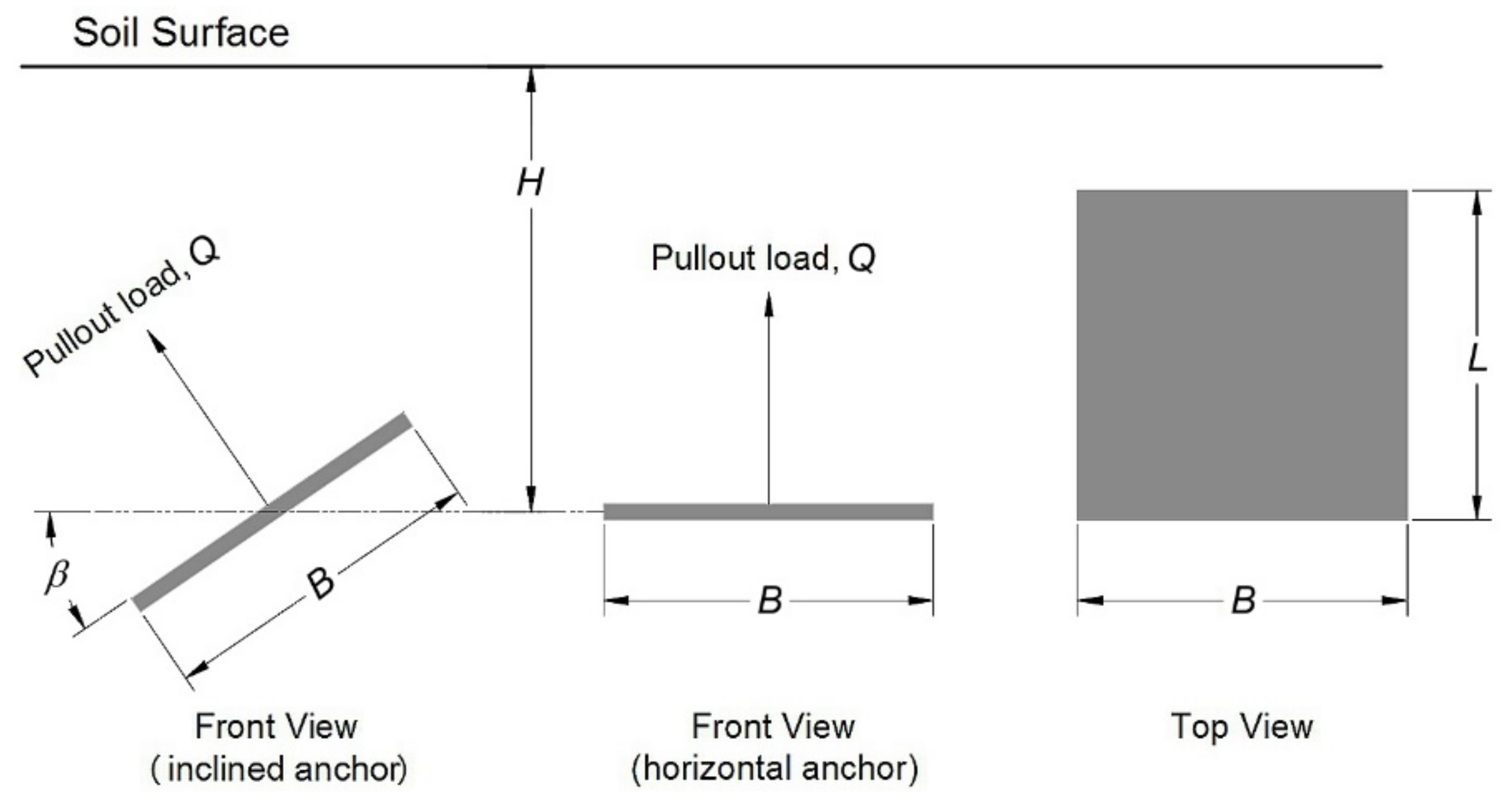
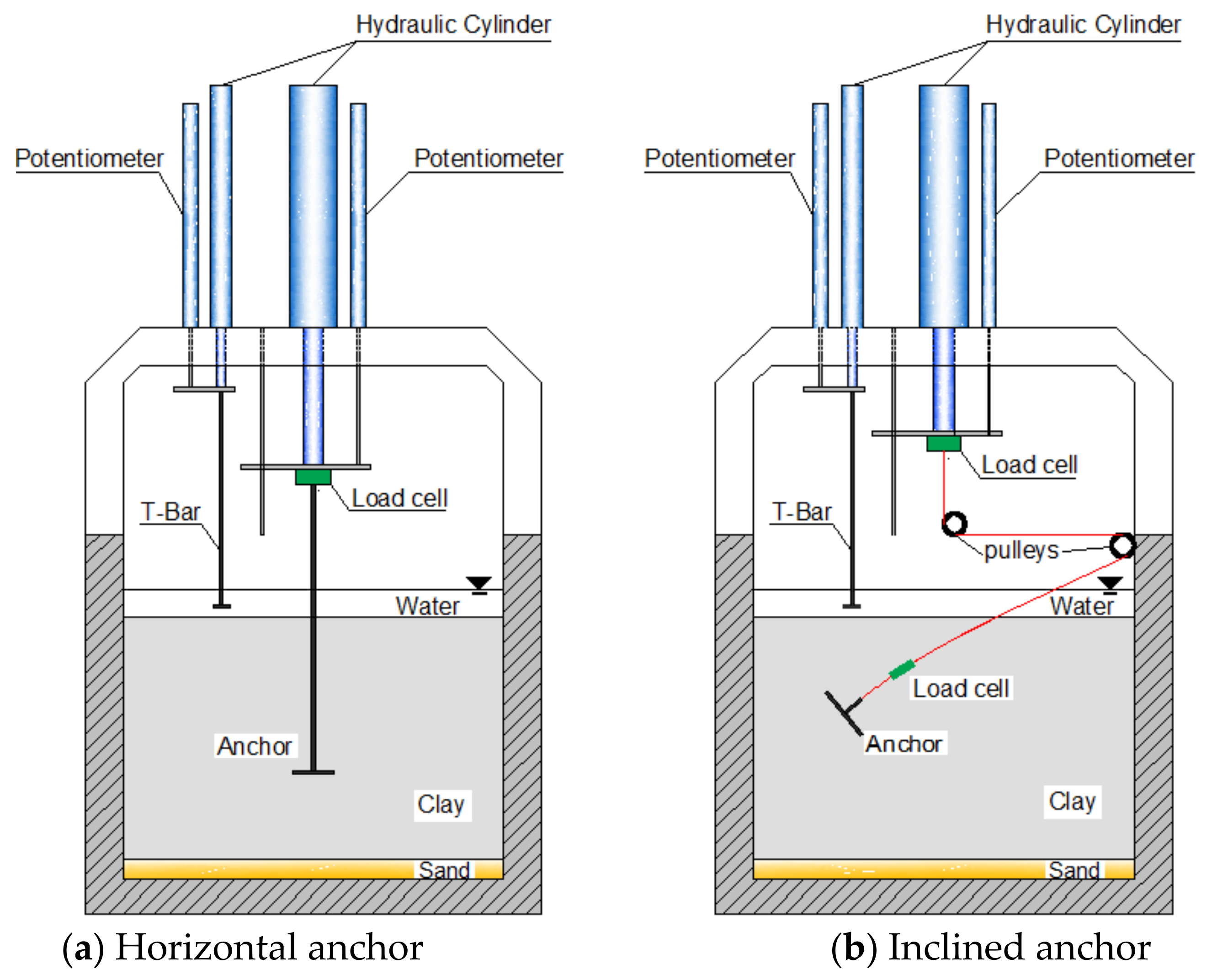



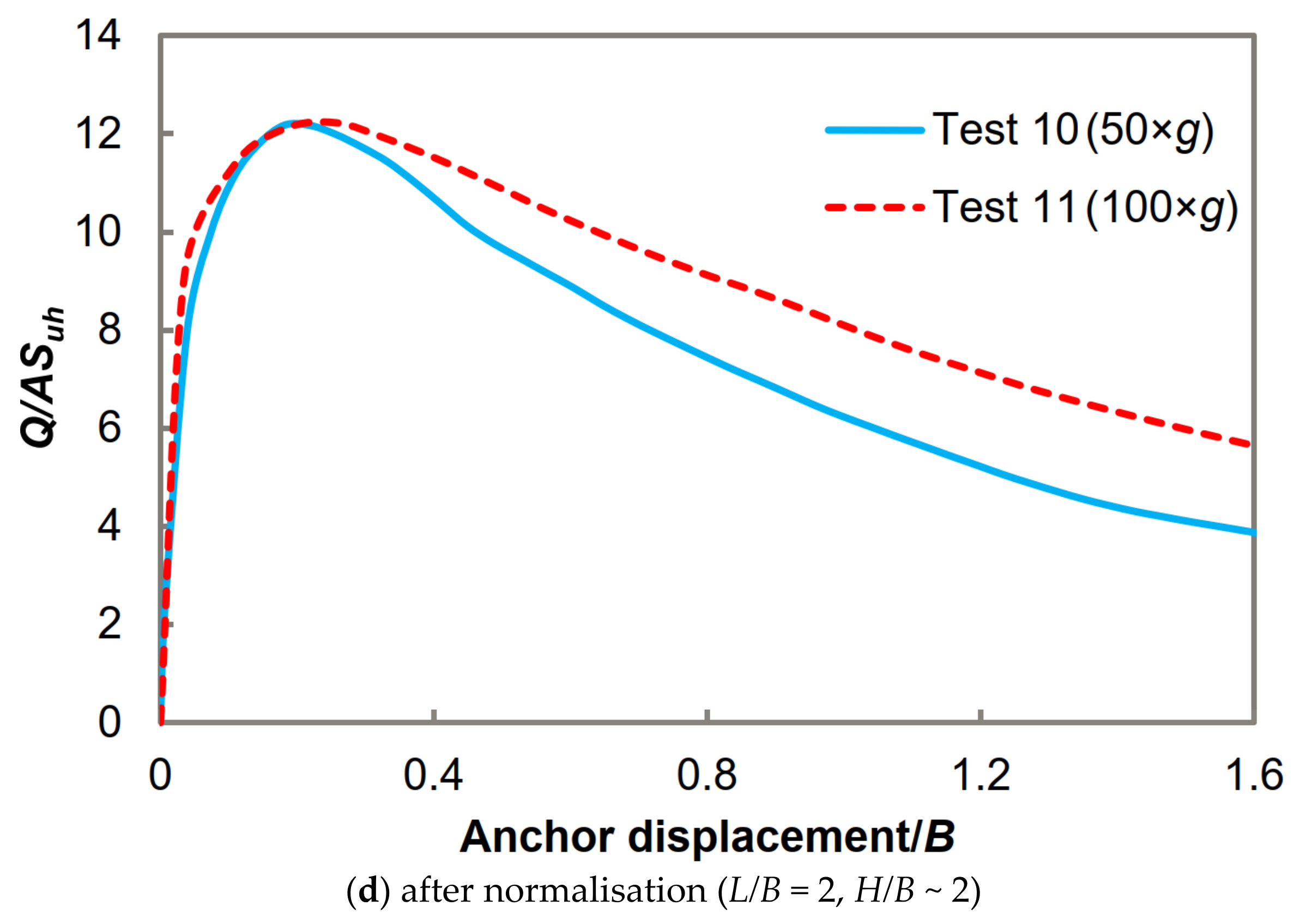
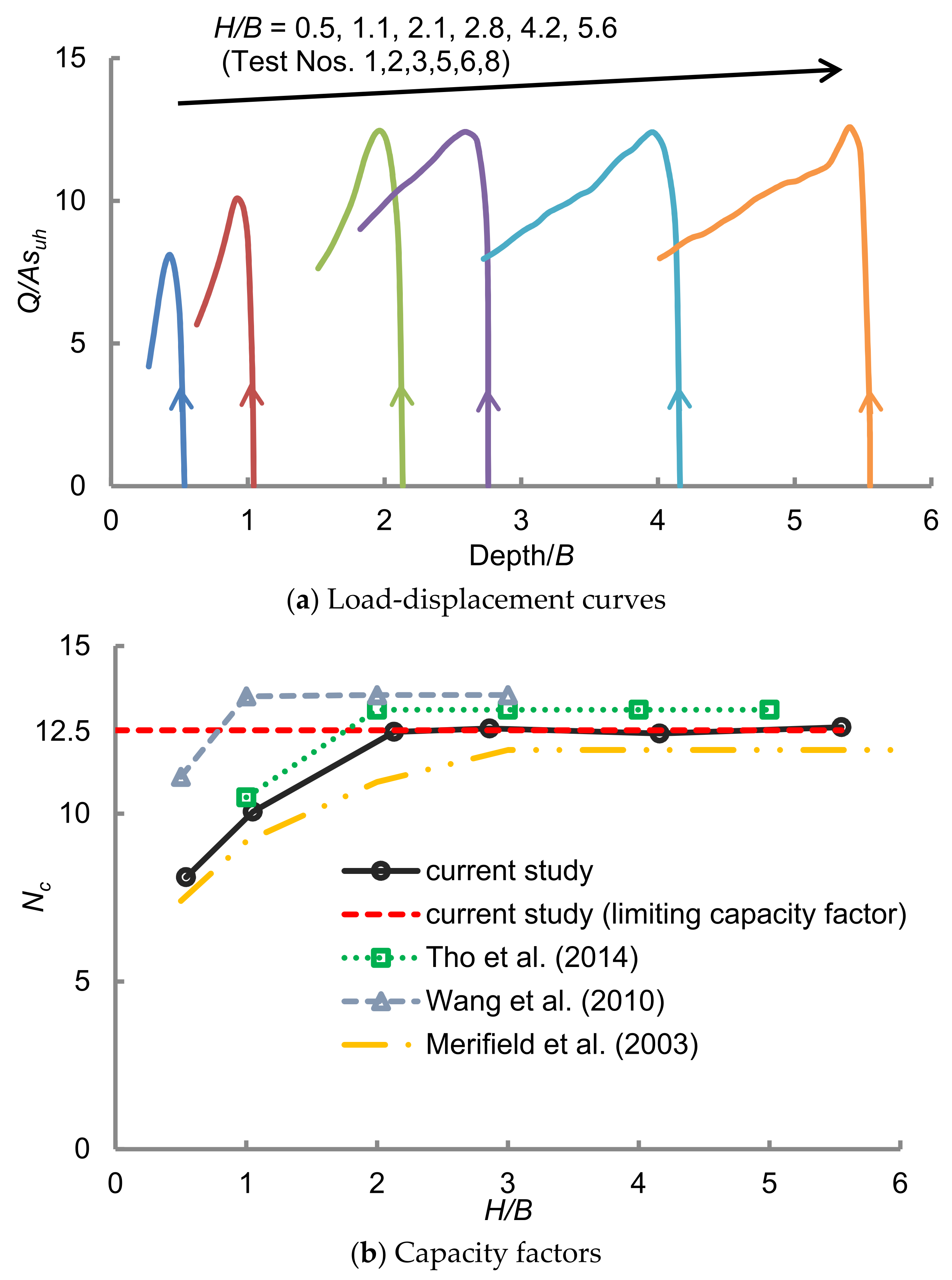
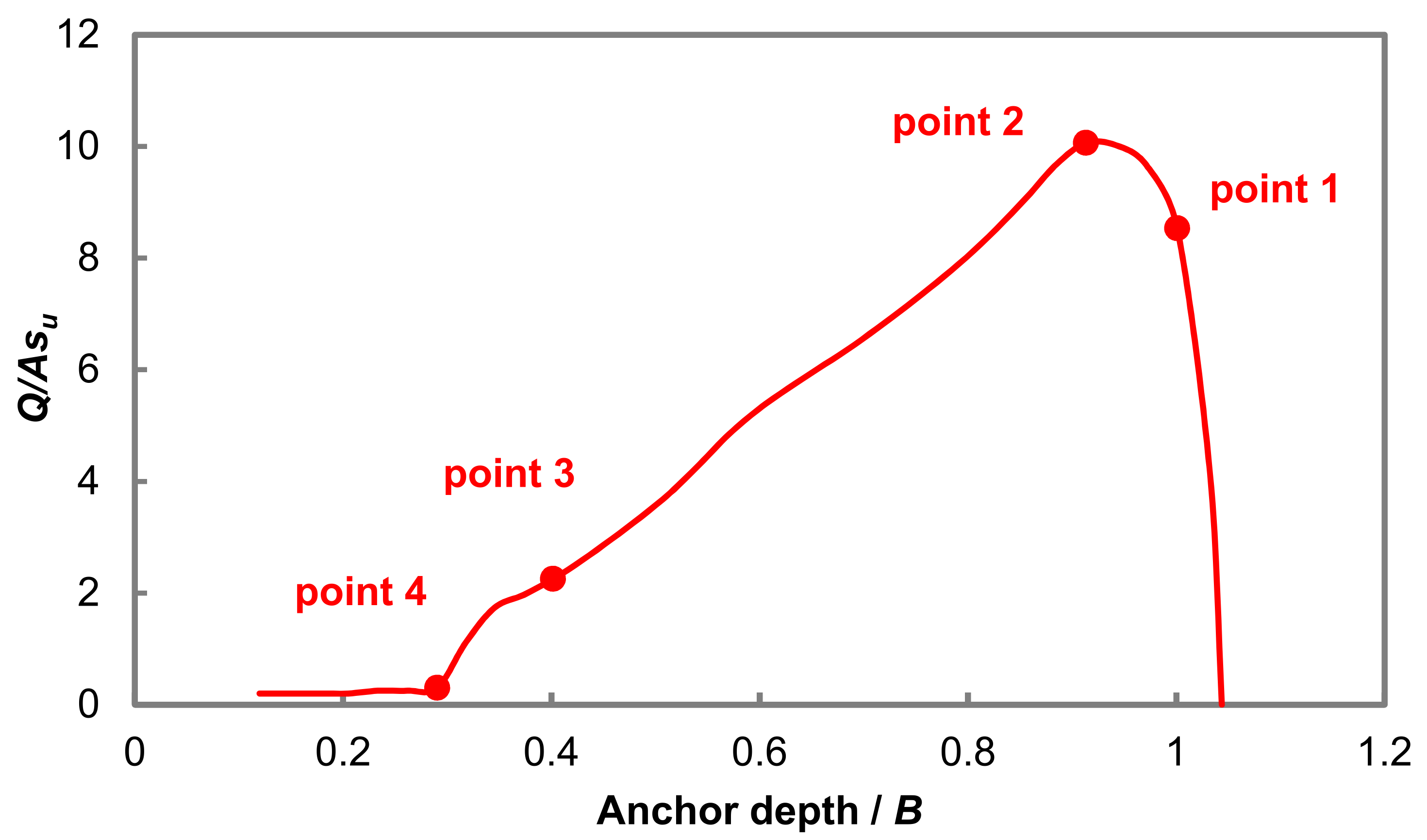
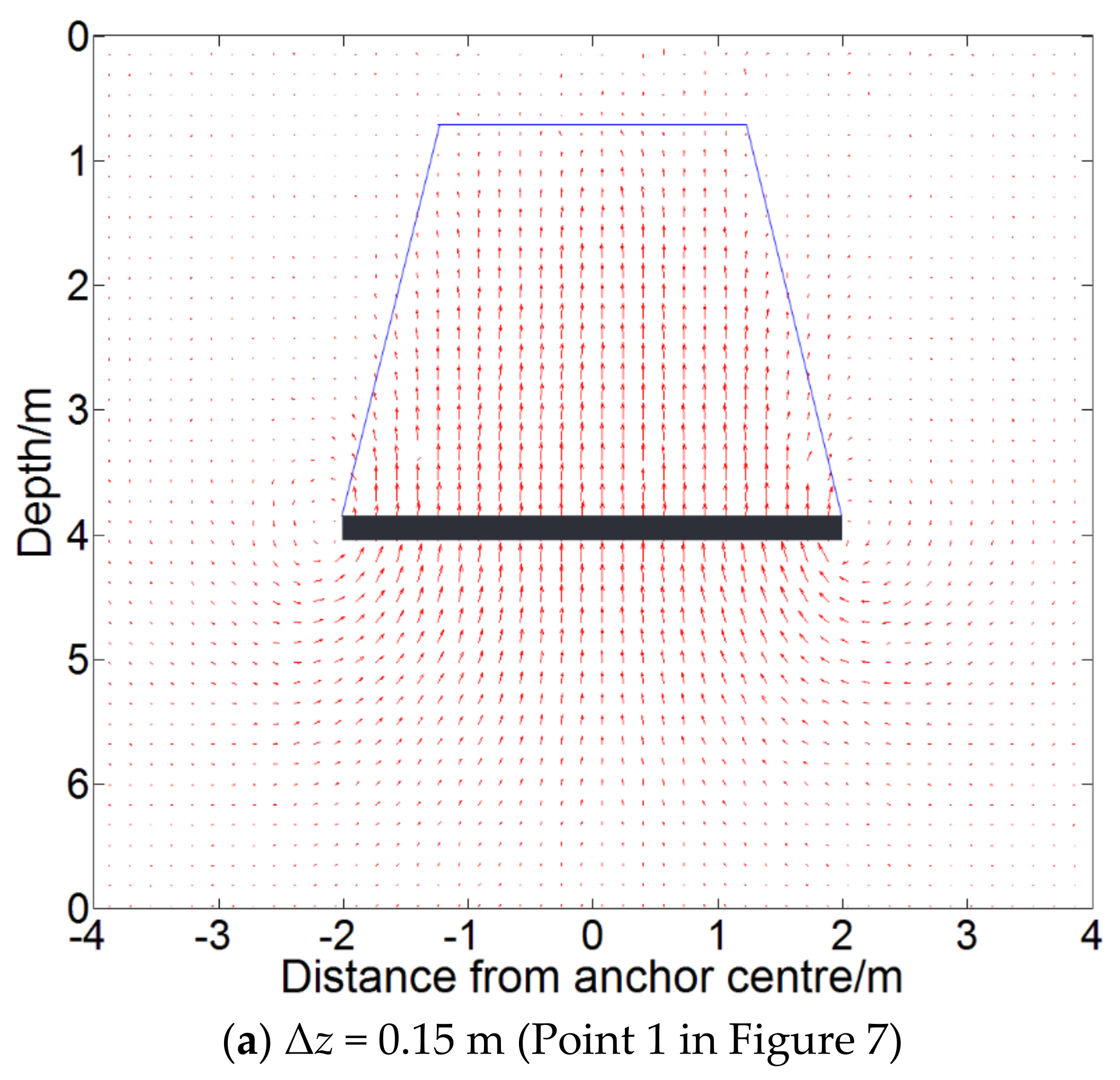

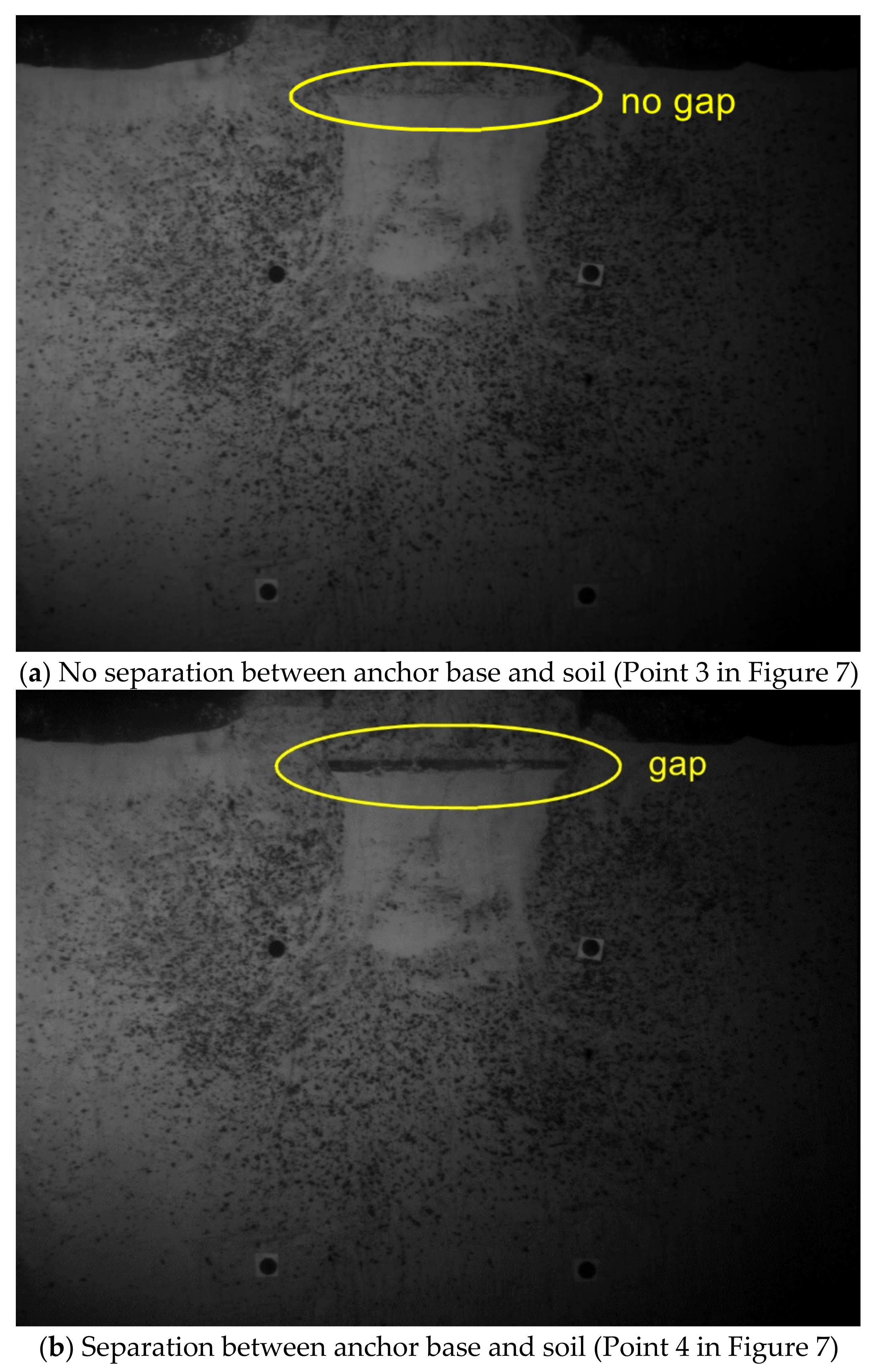
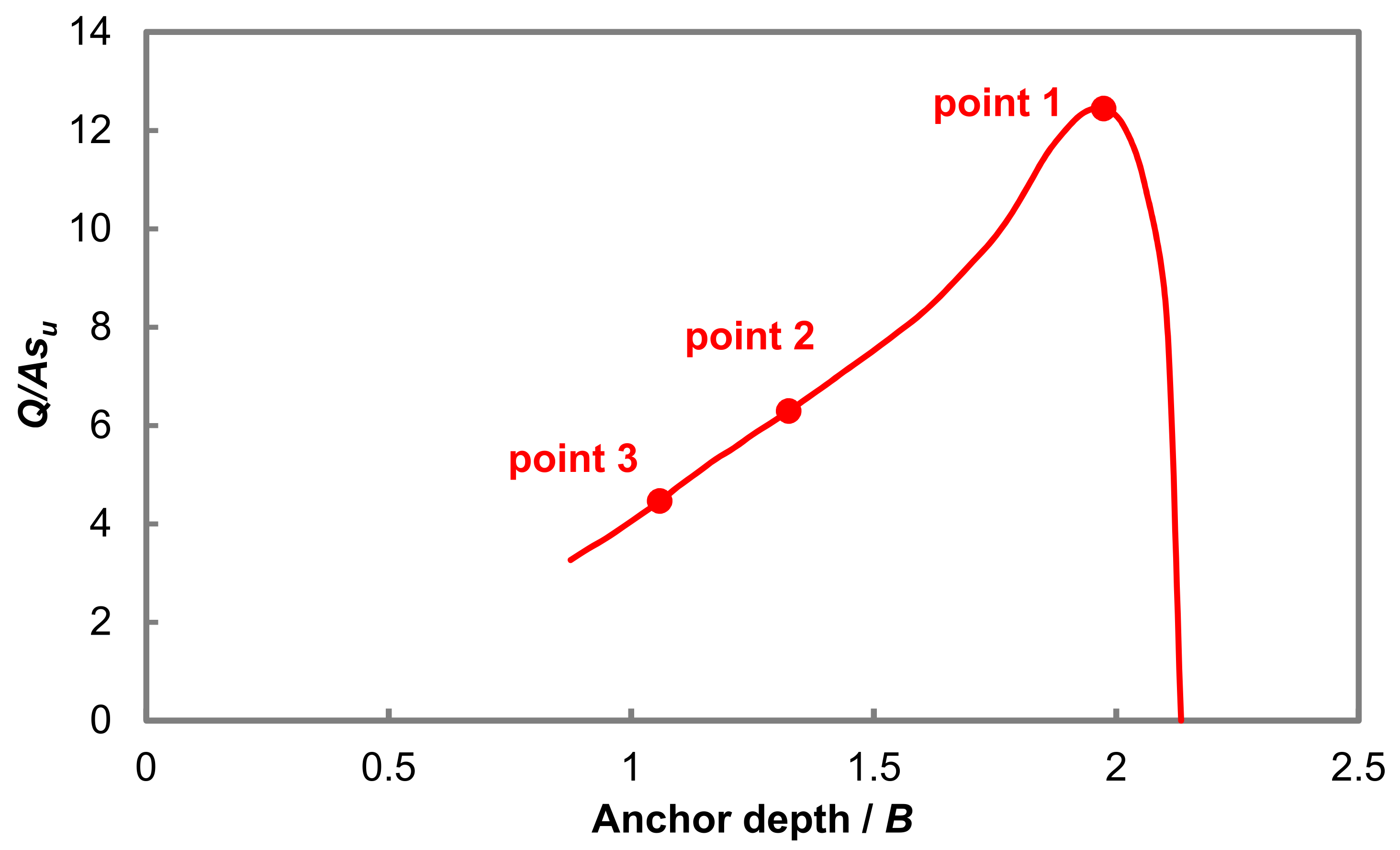
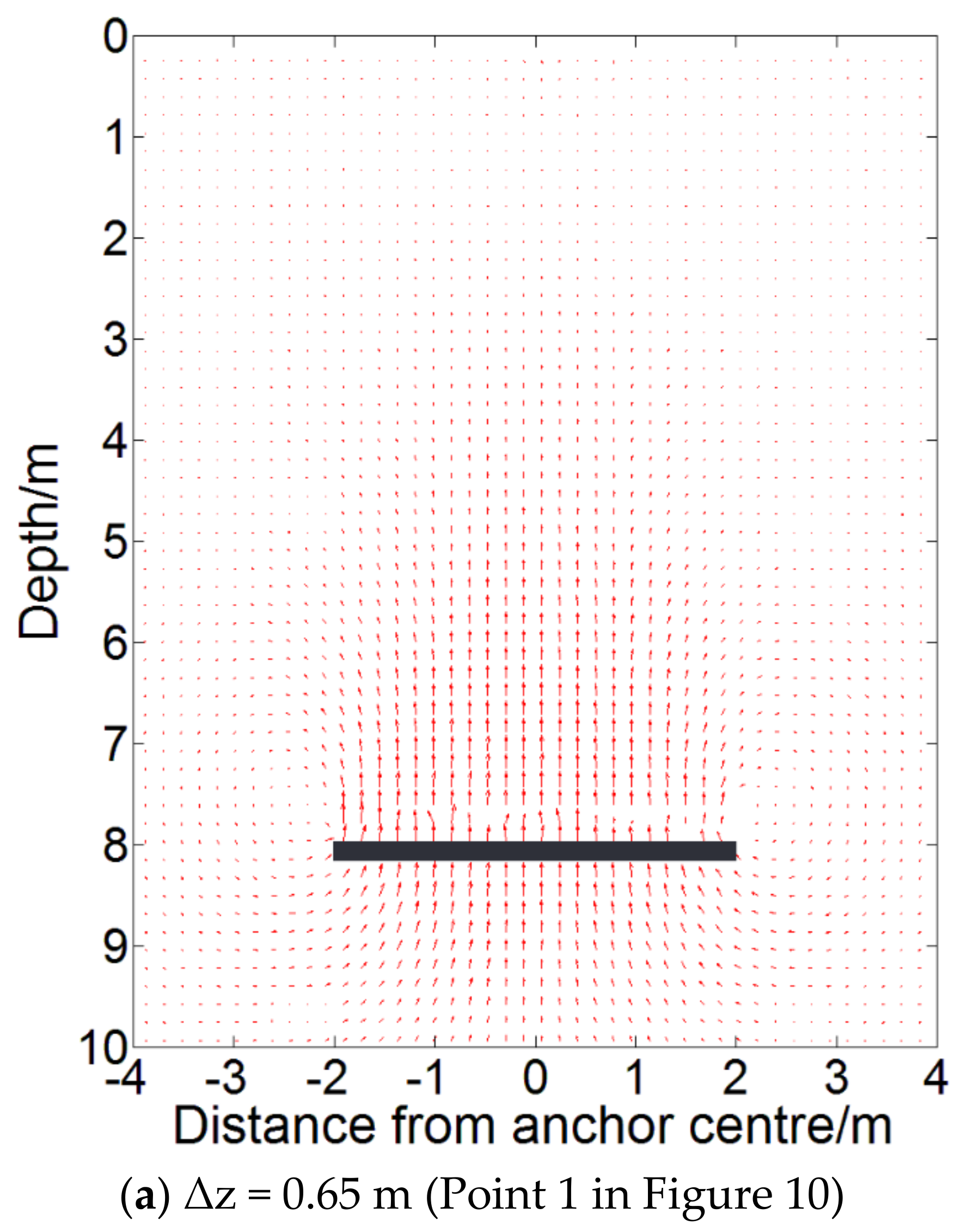
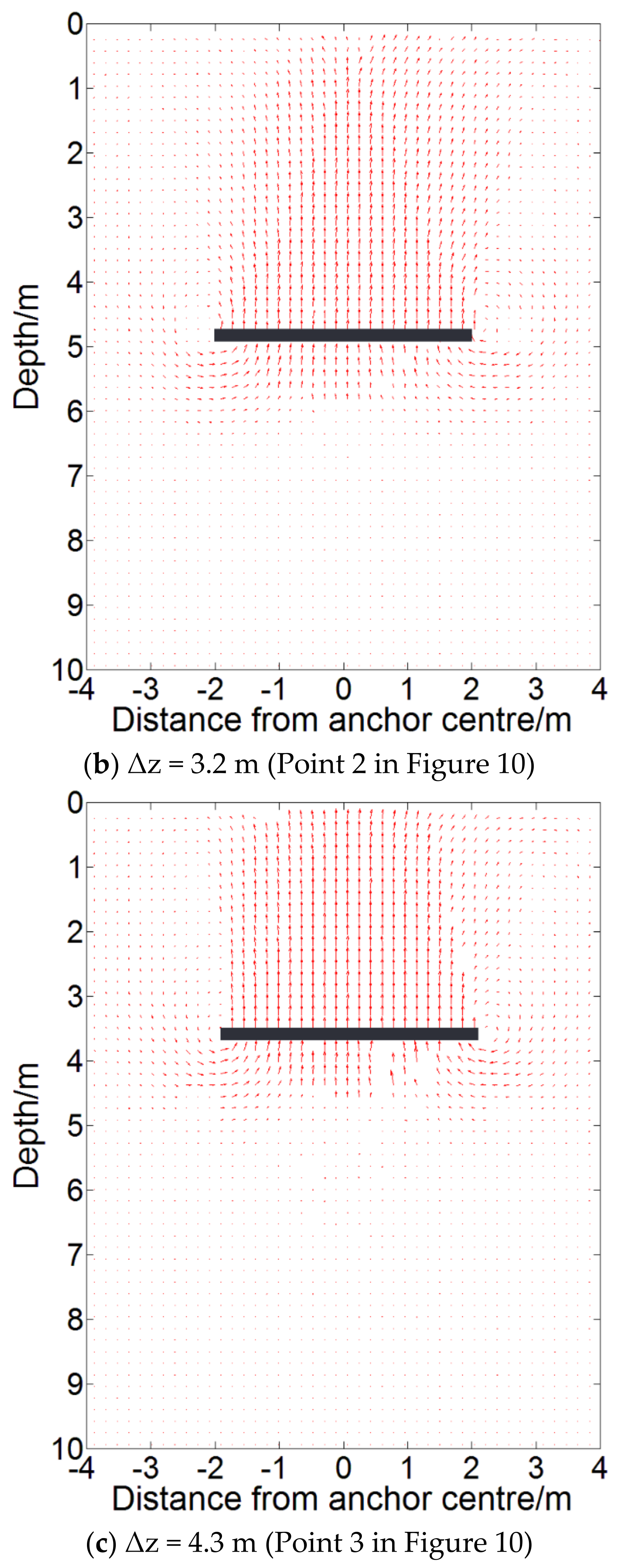

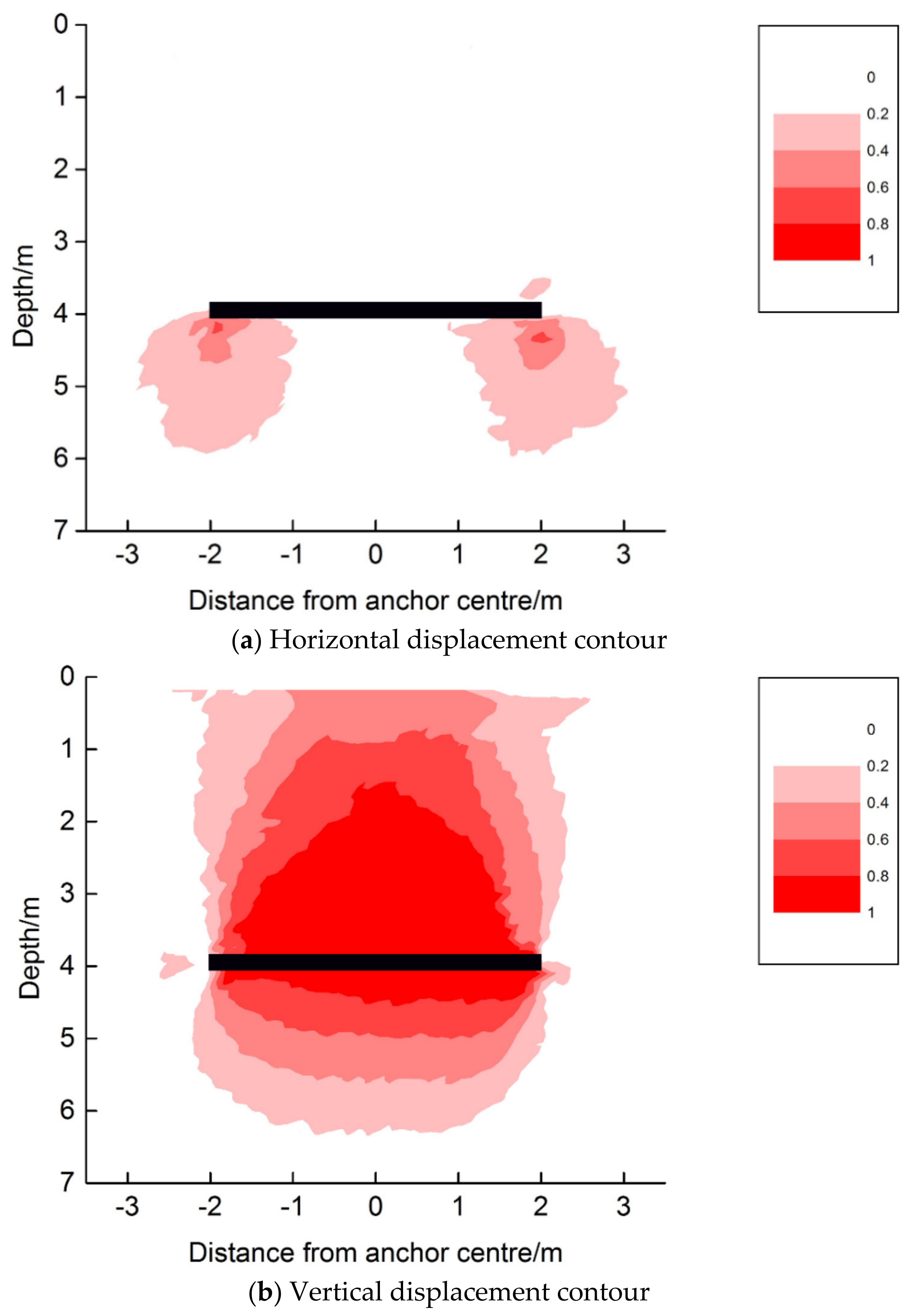
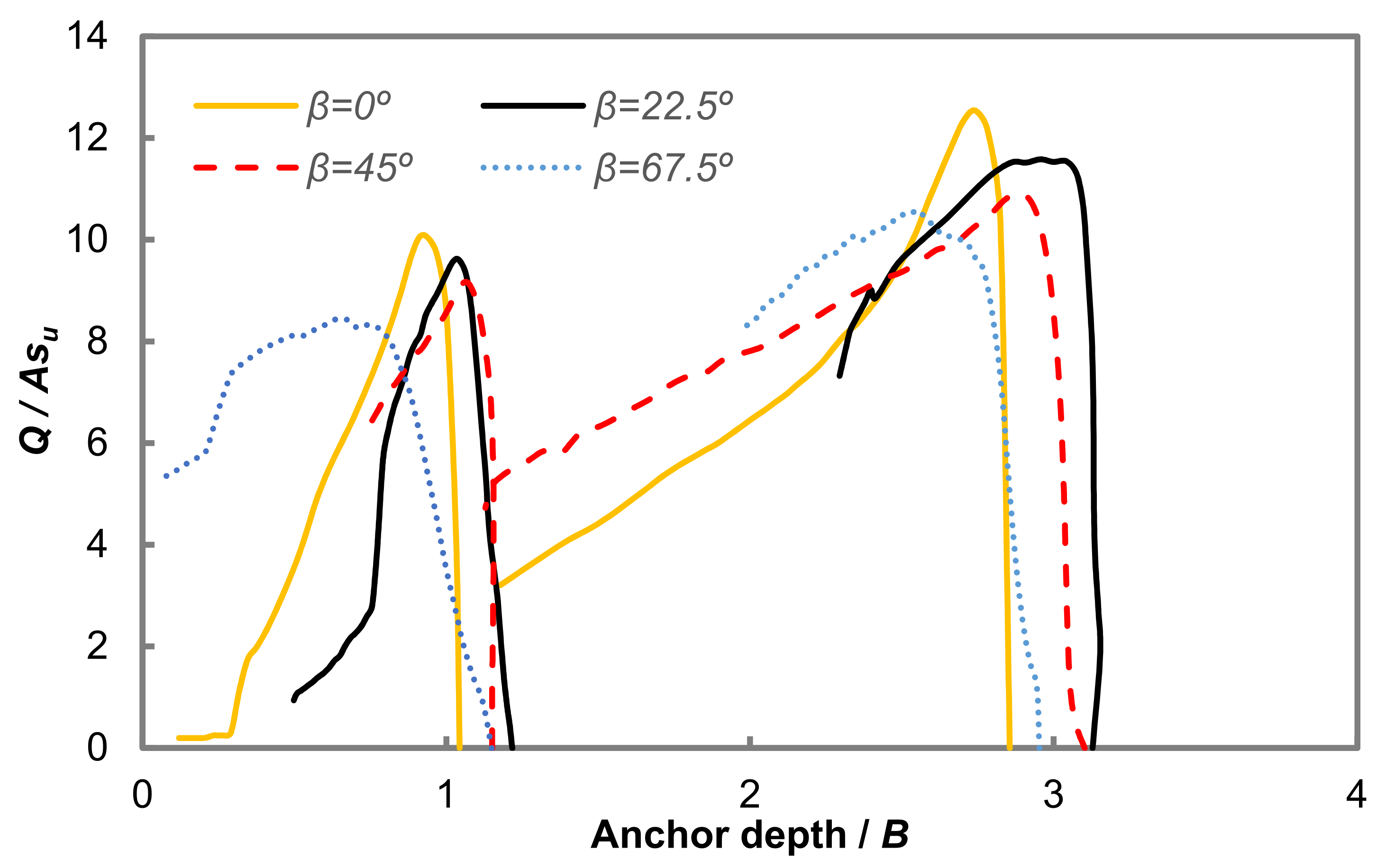
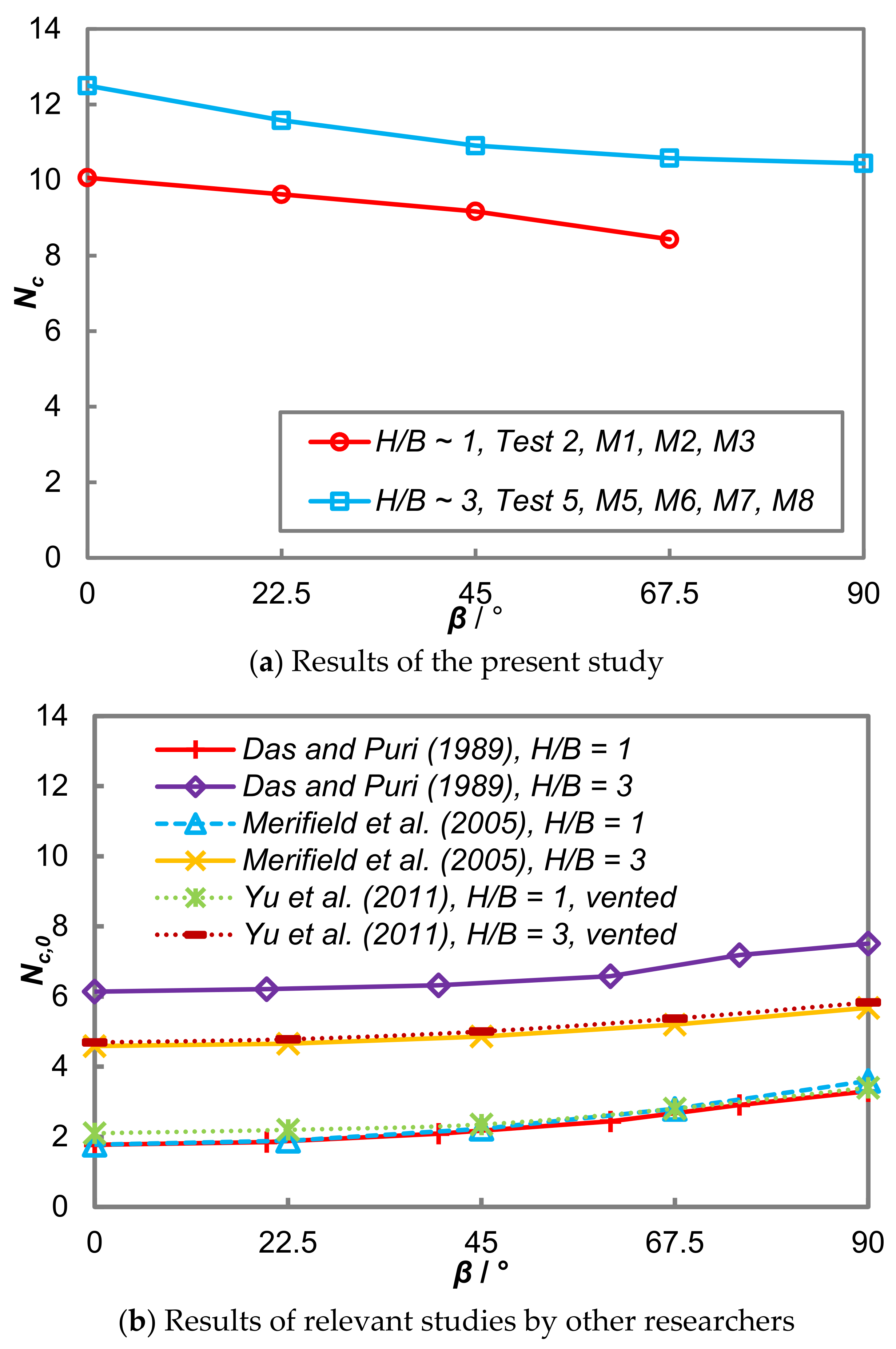
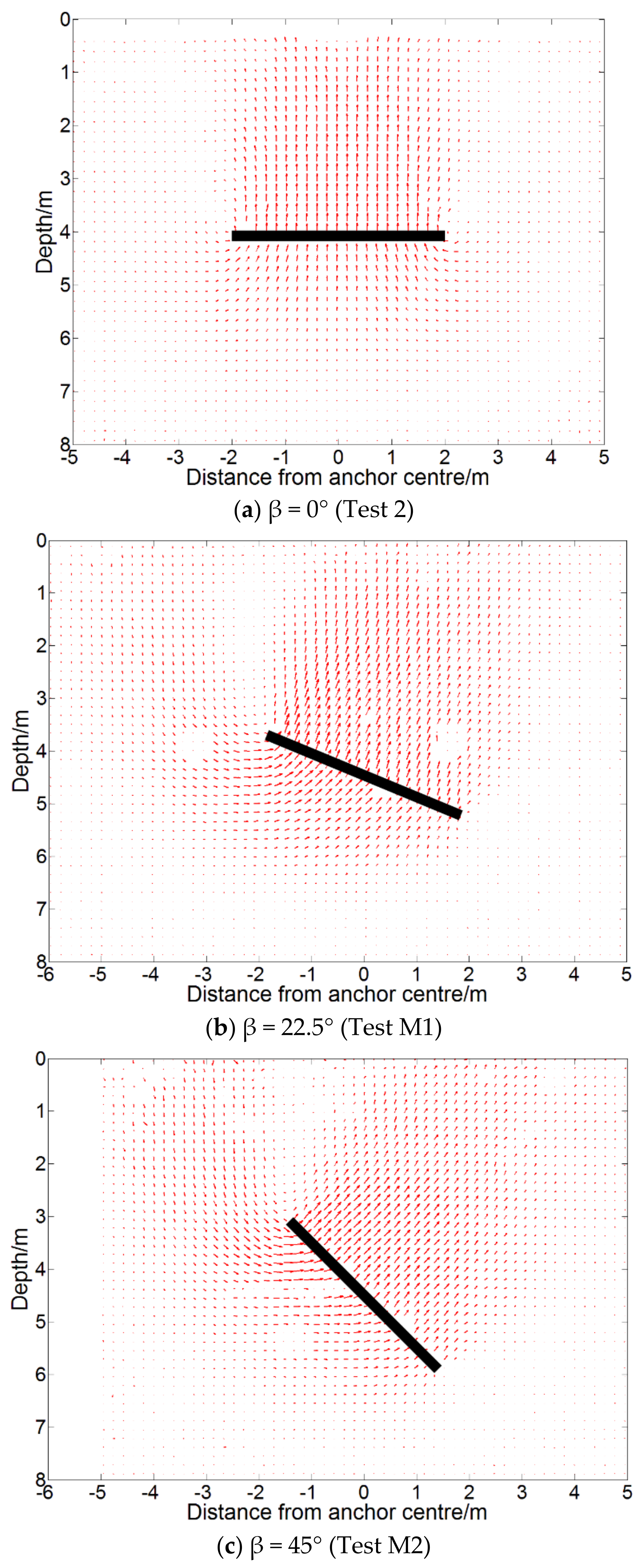
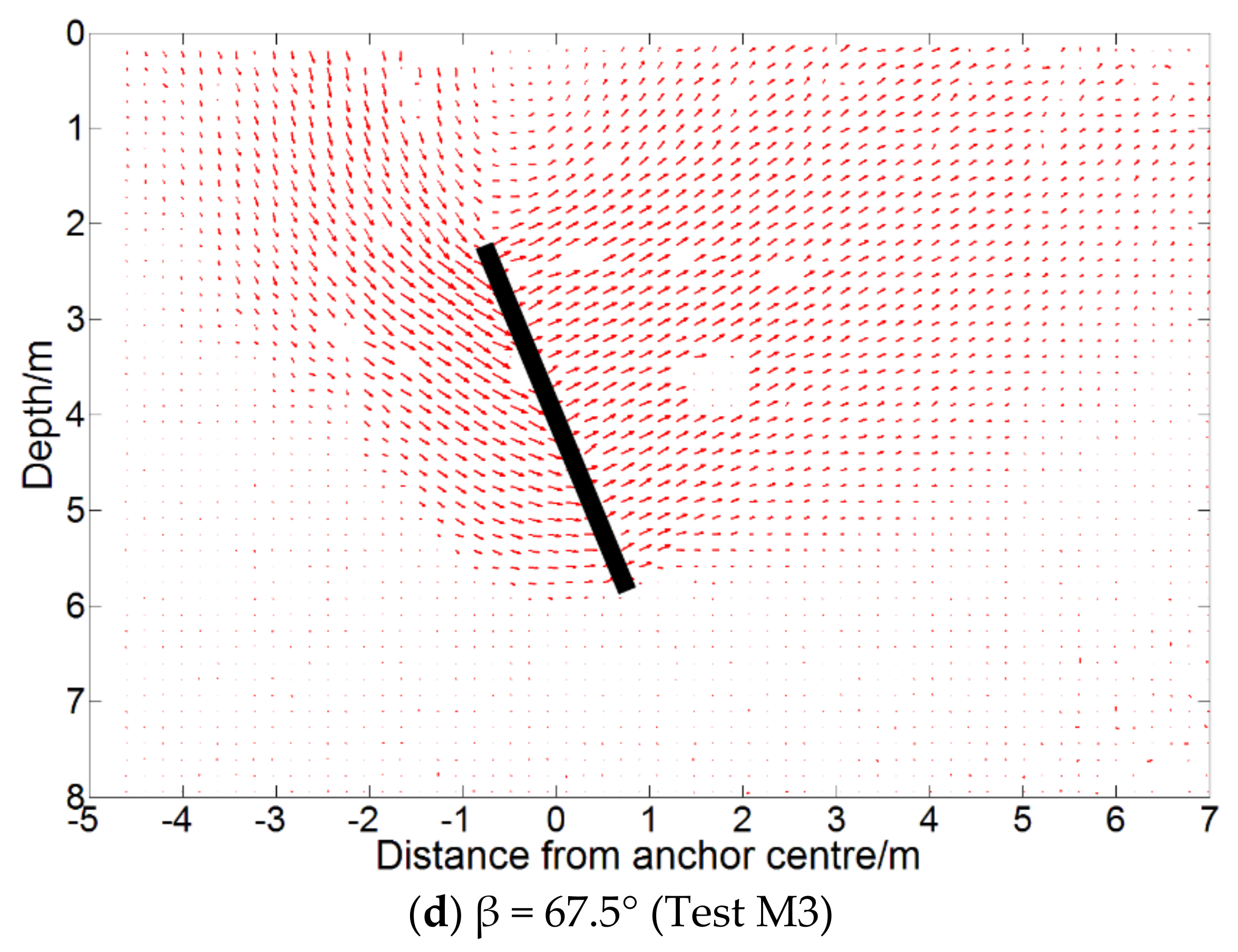
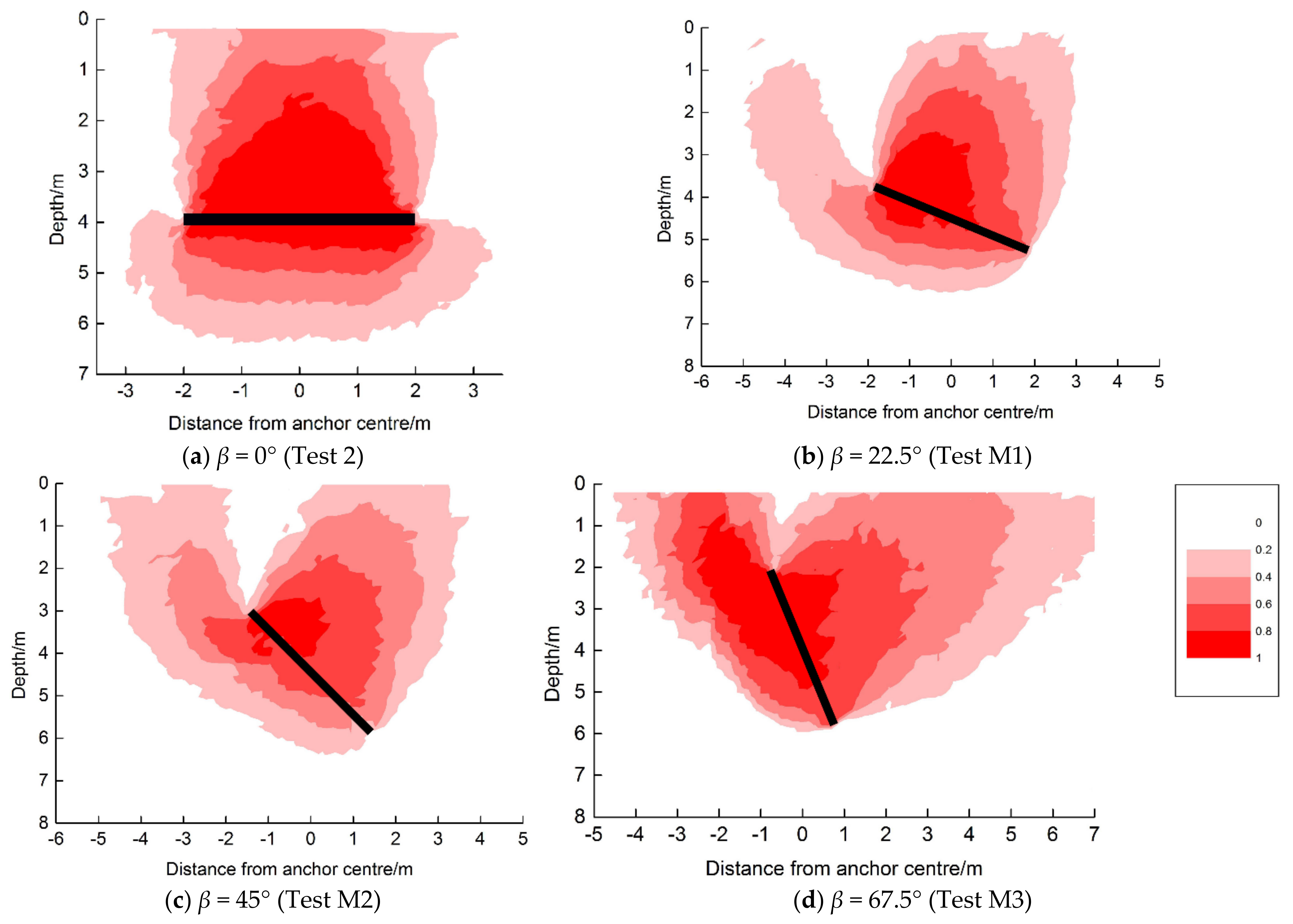
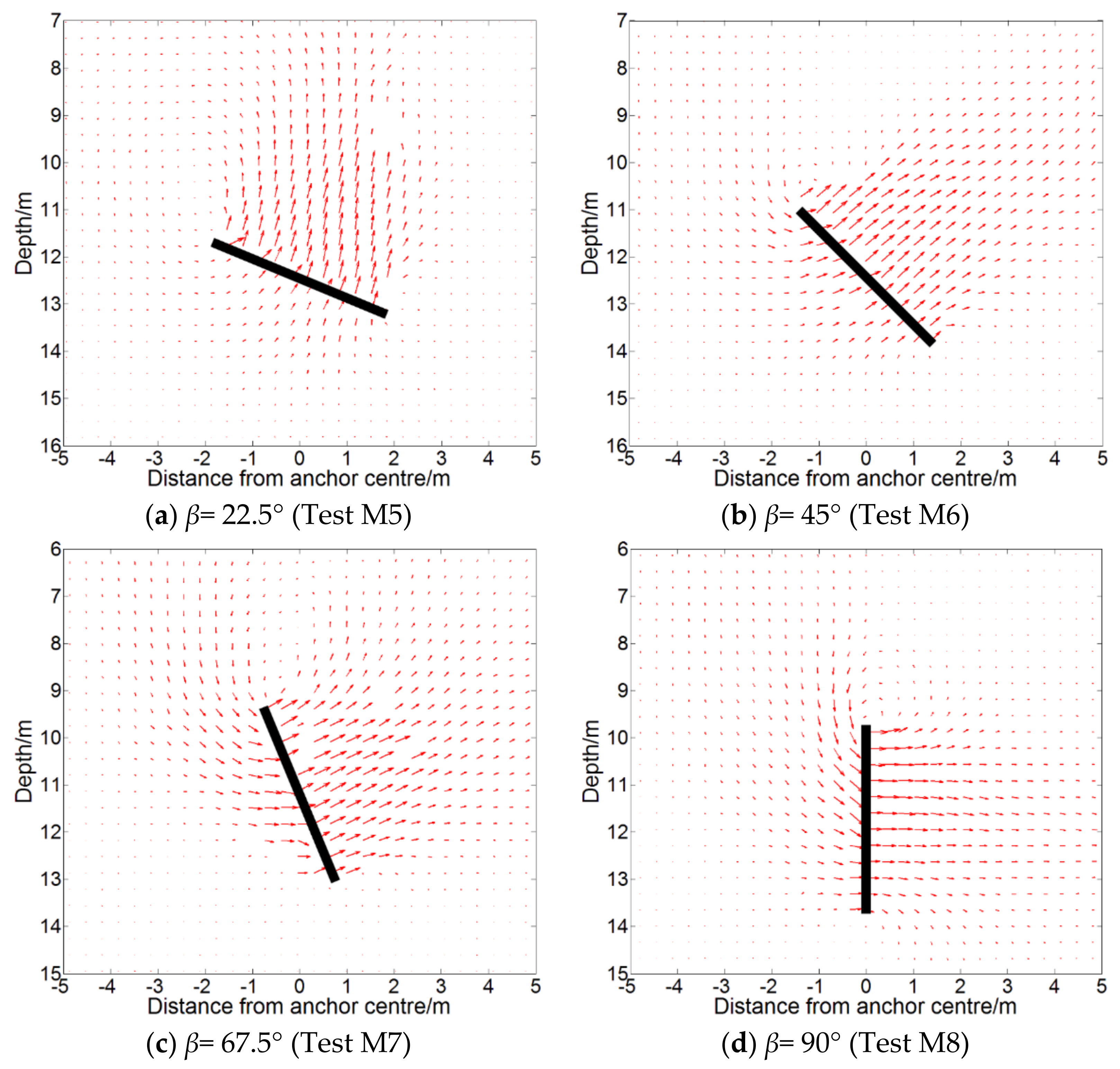


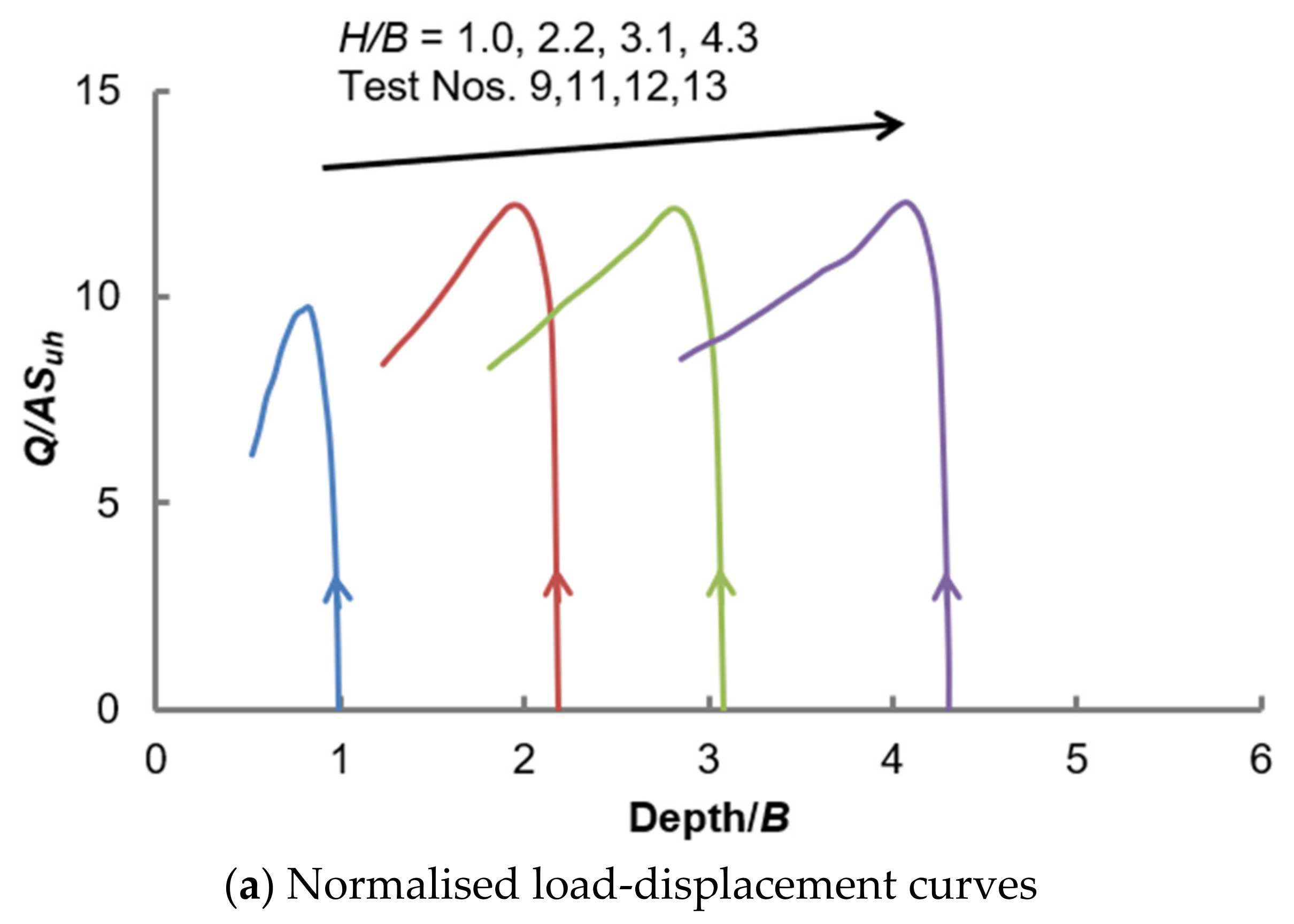

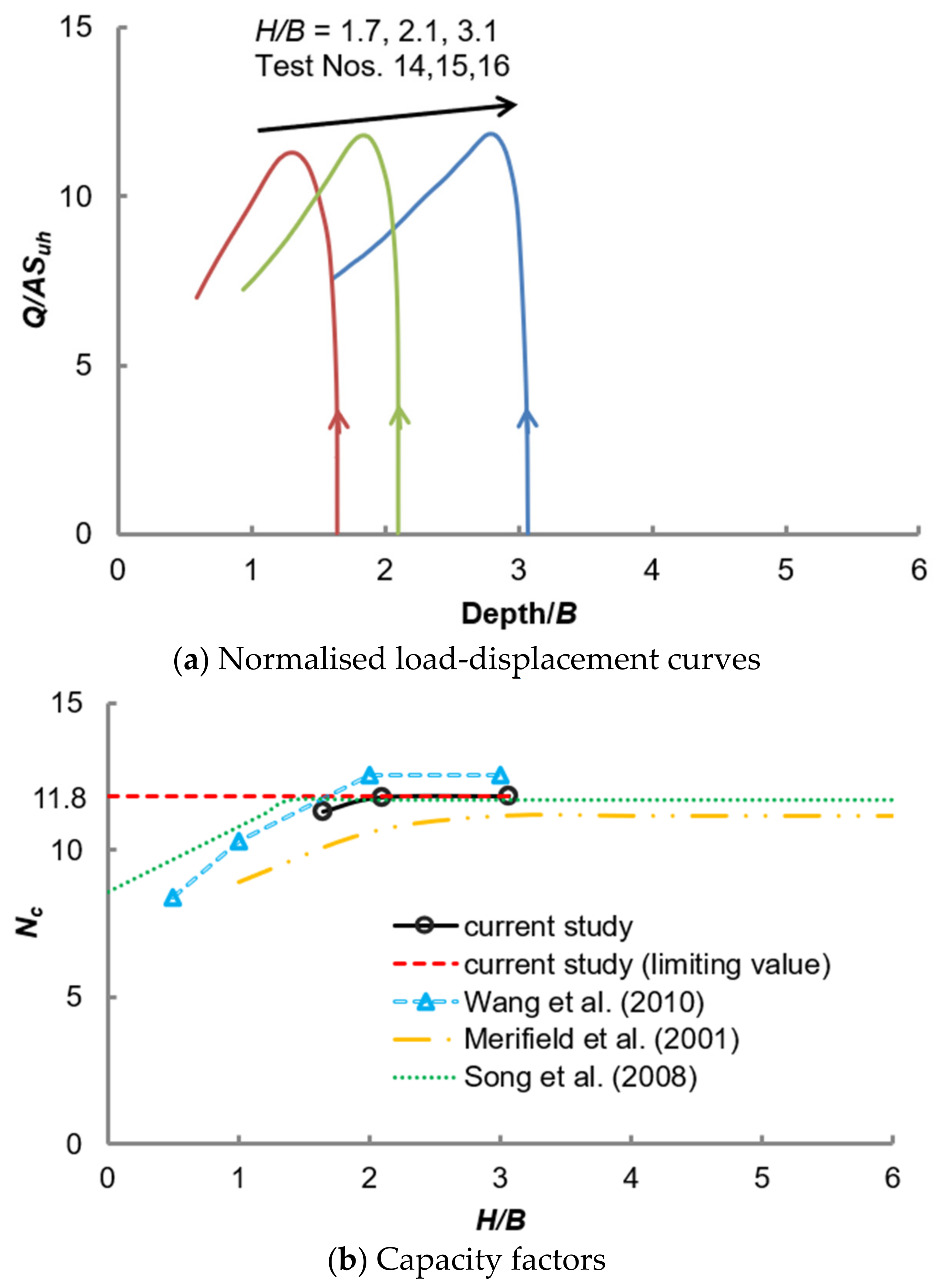
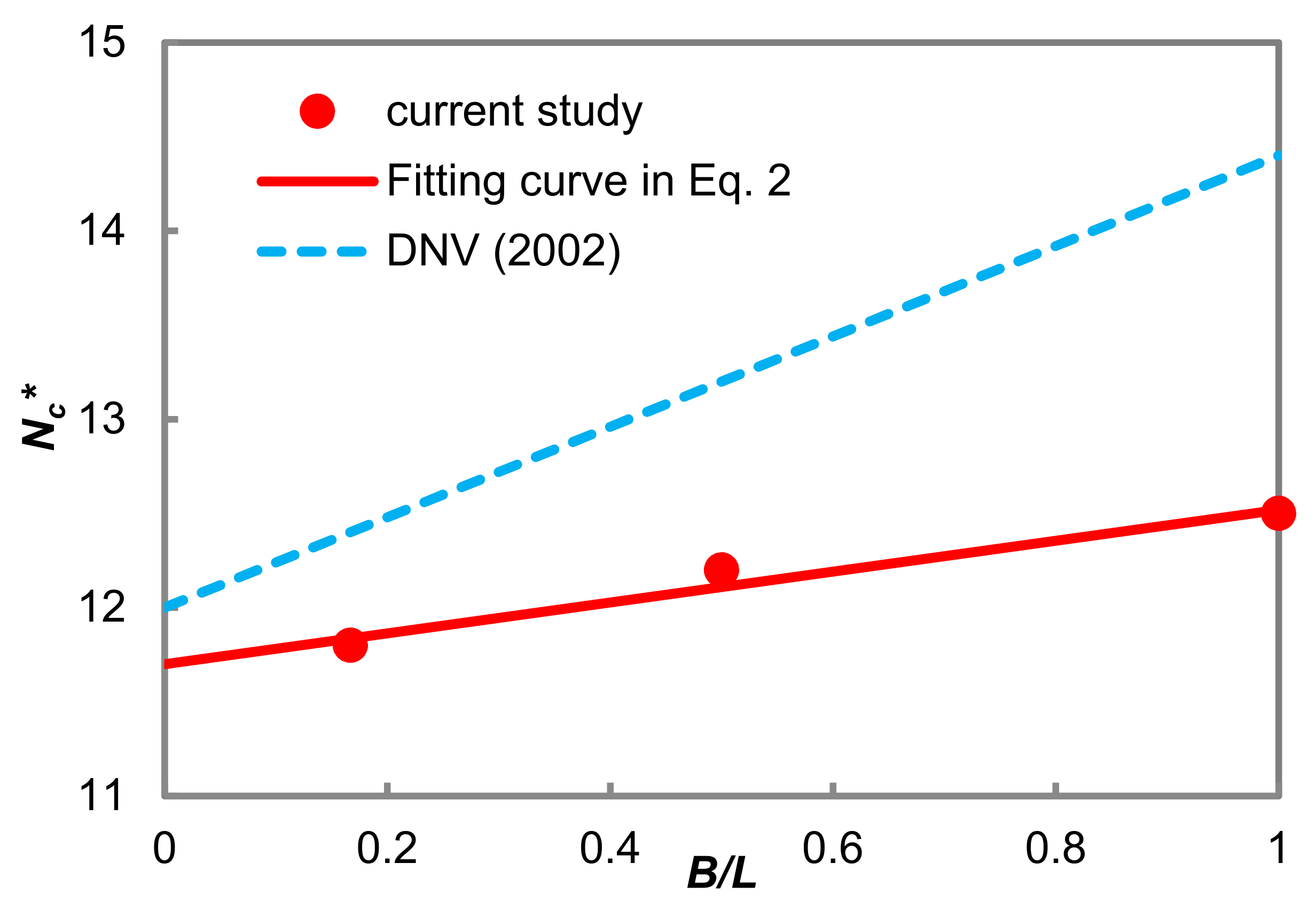
| Parameter | Magnitude |
|---|---|
| Liquid limit | 74% |
| Plastic limit | 35% |
| Specific gravity, Gs | 2.60 |
| Compression index Coefficient of consolidation | 0.473 15 m2/year |
| Coefficient of permeability at 100 kPa | 1.0 × 10−9 m/s |
| Aspect Ratio (L/B) | Test Number | g Level | H/B | Half Anchor Model Dimension |
|---|---|---|---|---|
| mm | ||||
| 1 (square) | 1 | 50 | 0.5 | 80 × 40 × 4 |
| 2 | 50 | 1.1 | 80 × 40 × 4 | |
| 3 | 50 | 2.1 | 80 × 40 × 4 | |
| 4 | 50 | 2.9 | 80 × 40 × 4 | |
| 5 | 100 | 2.8 | 40 × 20 × 2 | |
| 6 | 100 | 4.2 | 40 × 20 × 2 | |
| 7 | 100 | 4.6 | 40 × 20 × 2 | |
| 8 | 100 | 5.6 | 40 × 20 × 2 | |
| 2 (rectangular) | 9 | 50 | 1.0 | 80 × 80 × 4 |
| 10 | 50 | 2.1 | 80 × 80 × 4 | |
| 11 | 100 | 2.2 | 40 × 40 × 2 | |
| 12 | 100 | 3.1 | 40 × 40 × 2 | |
| 13 | 100 | 4.3 | 40 × 40 × 2 | |
| 6 (close to strip) | 14 | 100 | 1.7 | 40 × 120 × 2 |
| 15 | 100 | 2.1 | 40 × 120 × 2 | |
| 16 | 100 | 3.1 | 40 × 120 × 2 |
| Test Number | g Level | H/B | Anchor Inclination, β° | Half Anchor Model Dimension |
|---|---|---|---|---|
| mm | ||||
| M1 | 50 | 1.2 | 22.5 | 80 × 40 × 4 |
| M2 | 50 | 1.2 | 45 | 80 × 40 × 4 |
| M3 | 50 | 1.2 | 67.5 | 80 × 40 × 4 |
| M4 | 50 | 3.0 | 45 | 80 × 40 × 4 |
| M5 | 100 | 3.1 | 22.5 | 40 × 20 × 2 |
| M6 | 100 | 3.2 | 45 | 40 × 20 × 2 |
| M7 | 100 | 3.0 | 67.5 | 40 × 20 × 2 |
| M8 | 100 | 3.0 | 90 | 40 × 20 × 2 |
Publisher’s Note: MDPI stays neutral with regard to jurisdictional claims in published maps and institutional affiliations. |
© 2021 by the authors. Licensee MDPI, Basel, Switzerland. This article is an open access article distributed under the terms and conditions of the Creative Commons Attribution (CC BY) license (https://creativecommons.org/licenses/by/4.0/).
Share and Cite
Hu, C.; Chen, J.; Leung, C.F.; Chow, Y.K.; Li, Z. Pull-Out Mechanism of Horizontal and Inclined Plate Anchors in Normally Consolidated Clay. J. Mar. Sci. Eng. 2021, 9, 1103. https://doi.org/10.3390/jmse9101103
Hu C, Chen J, Leung CF, Chow YK, Li Z. Pull-Out Mechanism of Horizontal and Inclined Plate Anchors in Normally Consolidated Clay. Journal of Marine Science and Engineering. 2021; 9(10):1103. https://doi.org/10.3390/jmse9101103
Chicago/Turabian StyleHu, Cun, Junfeng Chen, Chun Fai Leung, Yean Khow Chow, and Zhichuan Li. 2021. "Pull-Out Mechanism of Horizontal and Inclined Plate Anchors in Normally Consolidated Clay" Journal of Marine Science and Engineering 9, no. 10: 1103. https://doi.org/10.3390/jmse9101103





